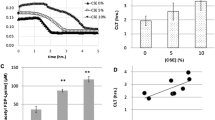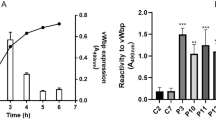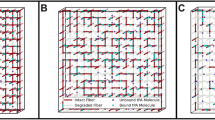Abstract
FIBRIN, the skeletal protein of thrombi, is derived from its soluble Pl.asma precursor, fibrinogen. Fibrinogen has a molecular weight of ∼340,000. It is composed of three pairs of subunit polypeptide chains, Aα, Bβ, and γ, of molecular weights 68,000, 56,000 and 49,000, respectively, joined by disulphide bonds. The serine protease thrombin releases fibrinopeptides A and B from the amino terminal end of the Aα- and Bβ-chains of fibrinogen to leave the α- and β-chains of fibrin monomer. Fibrin monomers then align by noncovalent interactions to give a fibrin polymer gel. Under the influence of thrombin-activated factor XIII (factor XHIa, activated fibrin stabilising factor, Plasma transglutaminase) and calcium ion, covalent ε-(γ-glu-tamyl)lysine crosslinks are rapidly formed between γ-chains of adjacent fibrin monomers to give the γ-dimer subunit of partially crosslinked fibrin1. The γ-crosslinking transforms the clot into a covalently bonded polymer, rendering it insoluble in 3 M urea and other agents that disrupt noncovalent interactions2. Extensive crosslinking of the α-chain to give the α-polymer subunit of fully crosslinked fibrin requires several hours in Plasma and confers relative Plasmin resistance to the clot3. We report here an increased rate and extent of α-crosslinking when red blood cells are present in the fibrin clot.
This is a preview of subscription content, access via your institution
Access options
Subscribe to this journal
Receive 51 print issues and online access
$199.00 per year
only $3.90 per issue
Buy this article
- Purchase on Springer Link
- Instant access to full article PDF
Prices may be subject to local taxes which are calculated during checkout
Similar content being viewed by others
References
McKee, P. A., Mattock, P. & Hill, R. L. Proc. natn. Acad. Sci. U.S.A. 66, 738–744 (1970); Chen, R. & Doolittle, R. F. Proc. natn. Acad. Sci. U.S.A. 66, 472–479 (1970).
Schwartz, M. L., Pizzo, S. V., Hill, R. L. & McKee, P. A. J. clin. Invest. 50, 1506–1513 (1971).
Schwartz, M. L., Pizzo, S. V., Hill, R. L. & McKee, P. A. J. biol. Chem. 248, 1395–1407 (1973).
Beutler, E., West, C. & Blume, K.-G. J. Lab. clin. Med. 88, 328–333 (1976).
Weber, K. & Osborn, M. J. biol. Chem. 244, 4406–4412 (1969); Laemmli, U. K. & Favre, M. J. molec. Biol. 80, 575–599 (1973).
Chung, S. I. & Folk, J. E. Fedn Proc. 34, 234 (1975).
Jacob, H. S. & Jandl, J. H. J. clin. Invest. 41, 779–792 (1962).
Fairbanks, G., Steck, T. L. & Wallach, D. F. H. Biochemistry 10, 2606–2617 (1971).
Author information
Authors and Affiliations
Rights and permissions
About this article
Cite this article
FERGUSON, E., SANDER, G. Fibrin ε-(γ-glutamyl)lysine crosslink acceleration by red blood cells. Nature 278, 183–185 (1979). https://doi.org/10.1038/278183a0
Received:
Accepted:
Published:
Issue Date:
DOI: https://doi.org/10.1038/278183a0
Comments
By submitting a comment you agree to abide by our Terms and Community Guidelines. If you find something abusive or that does not comply with our terms or guidelines please flag it as inappropriate.



